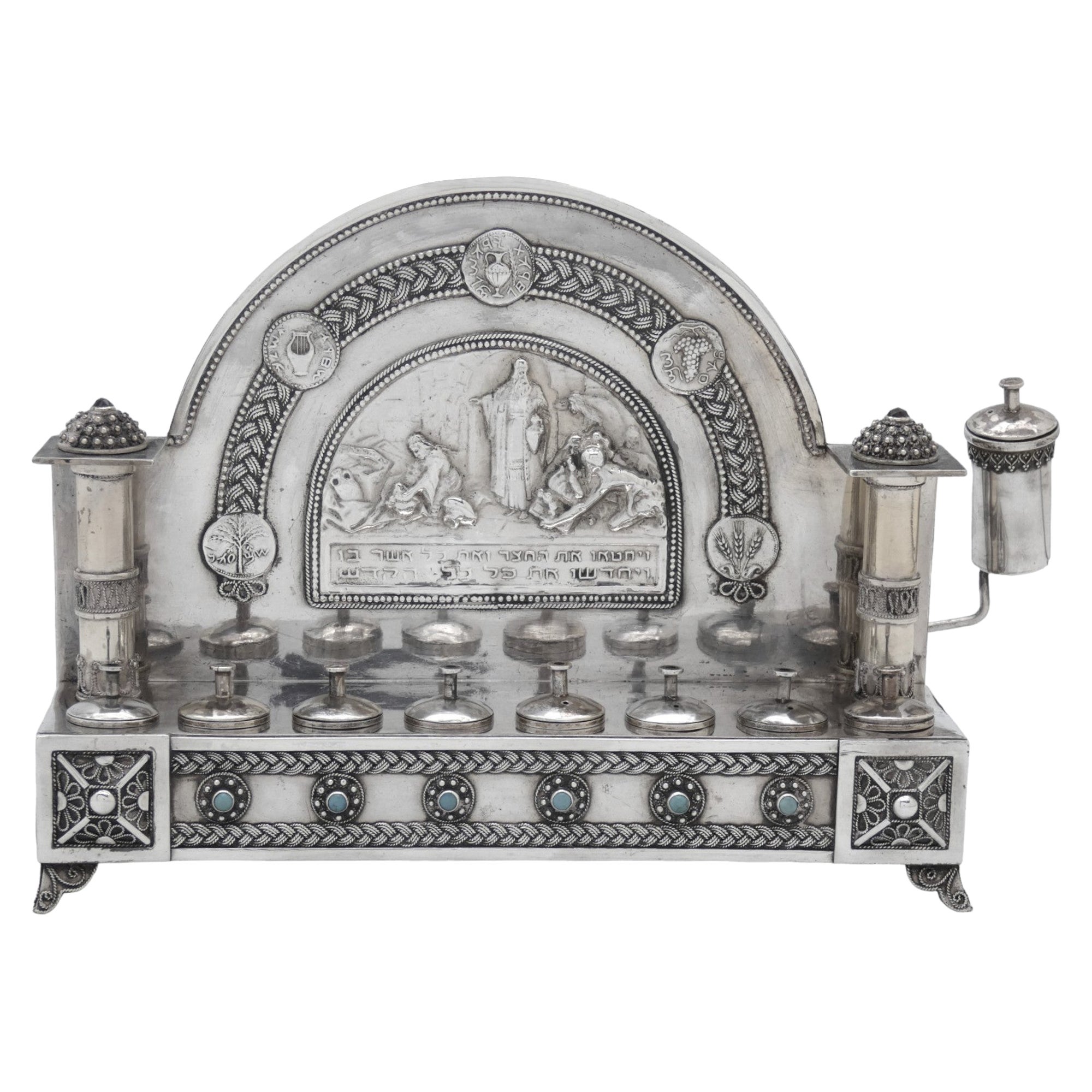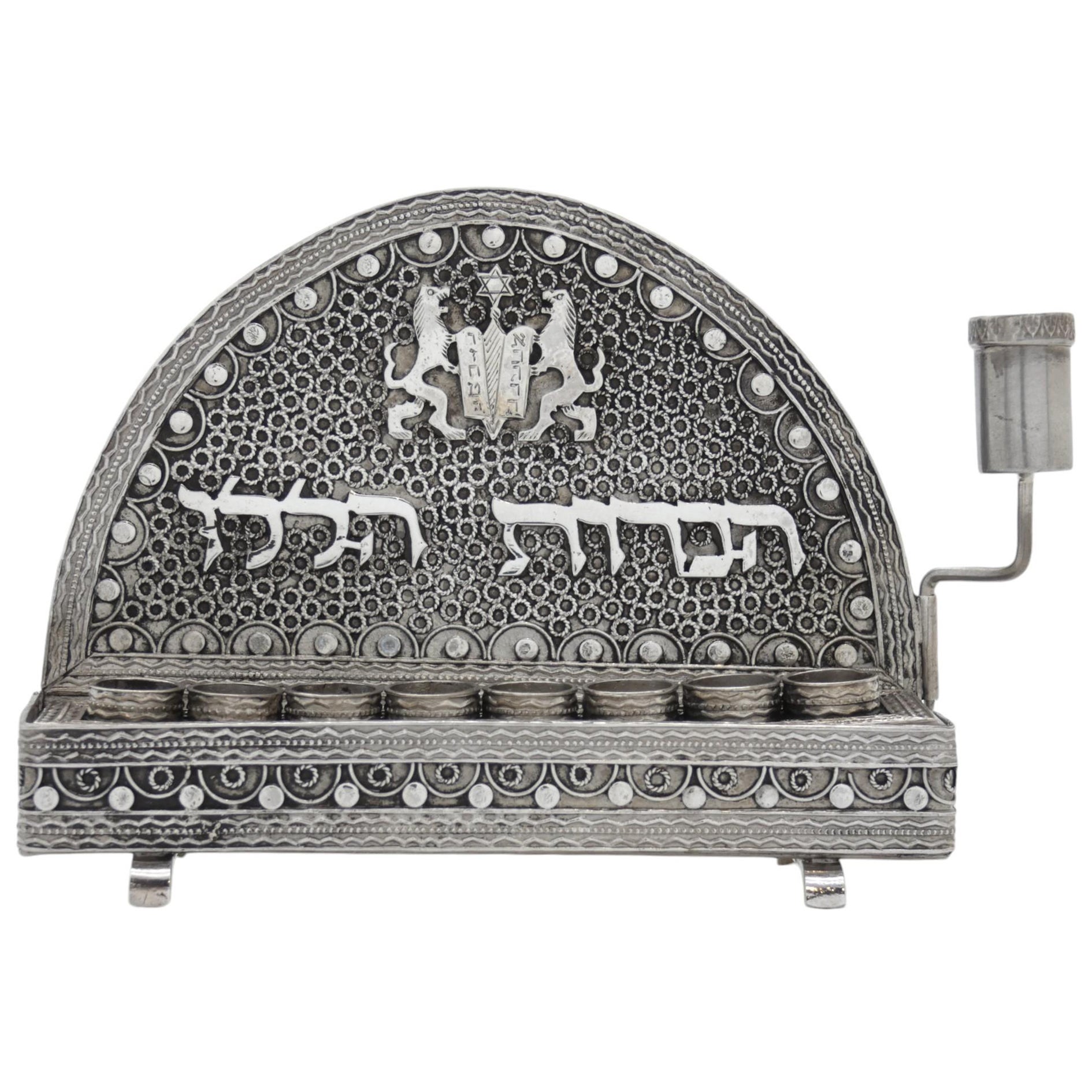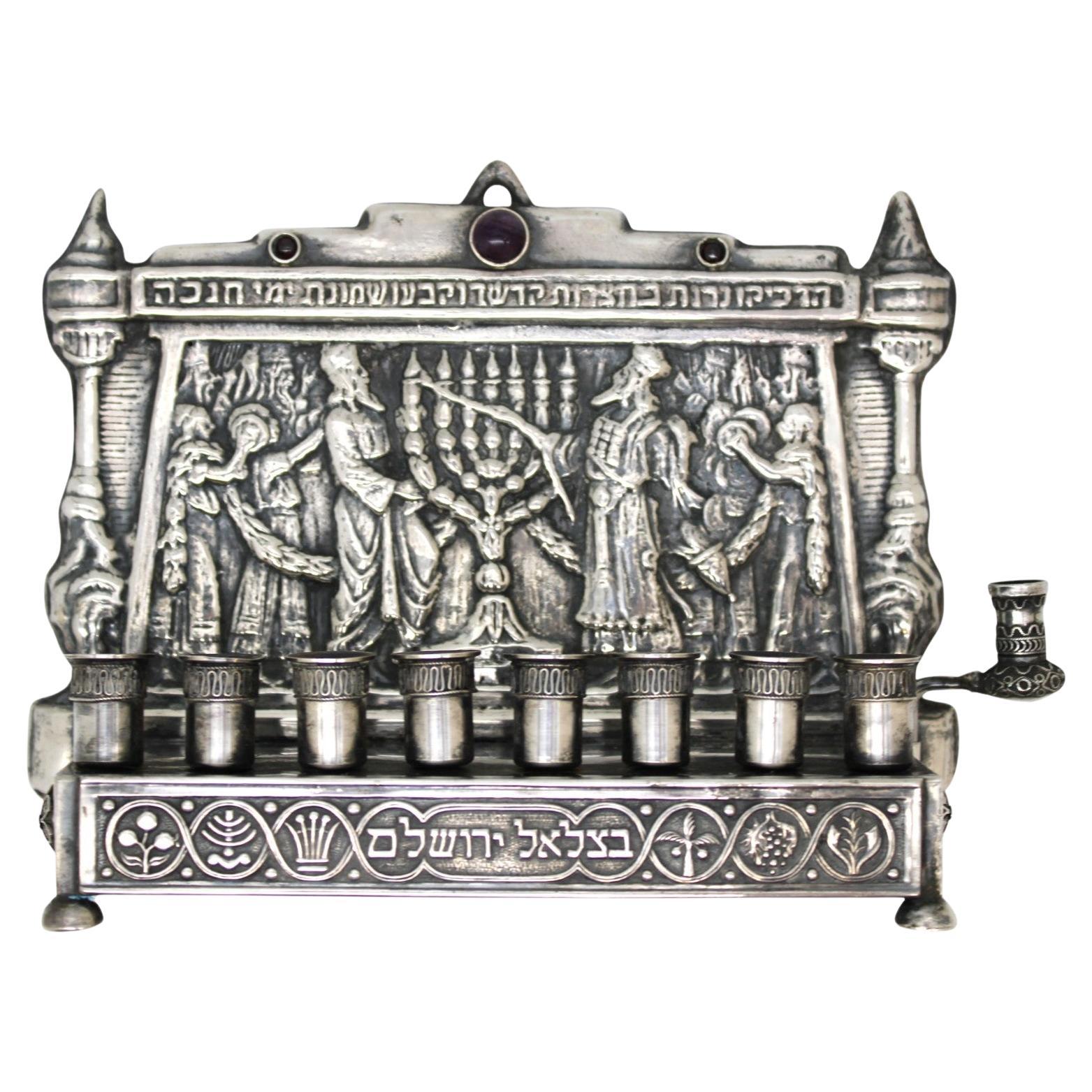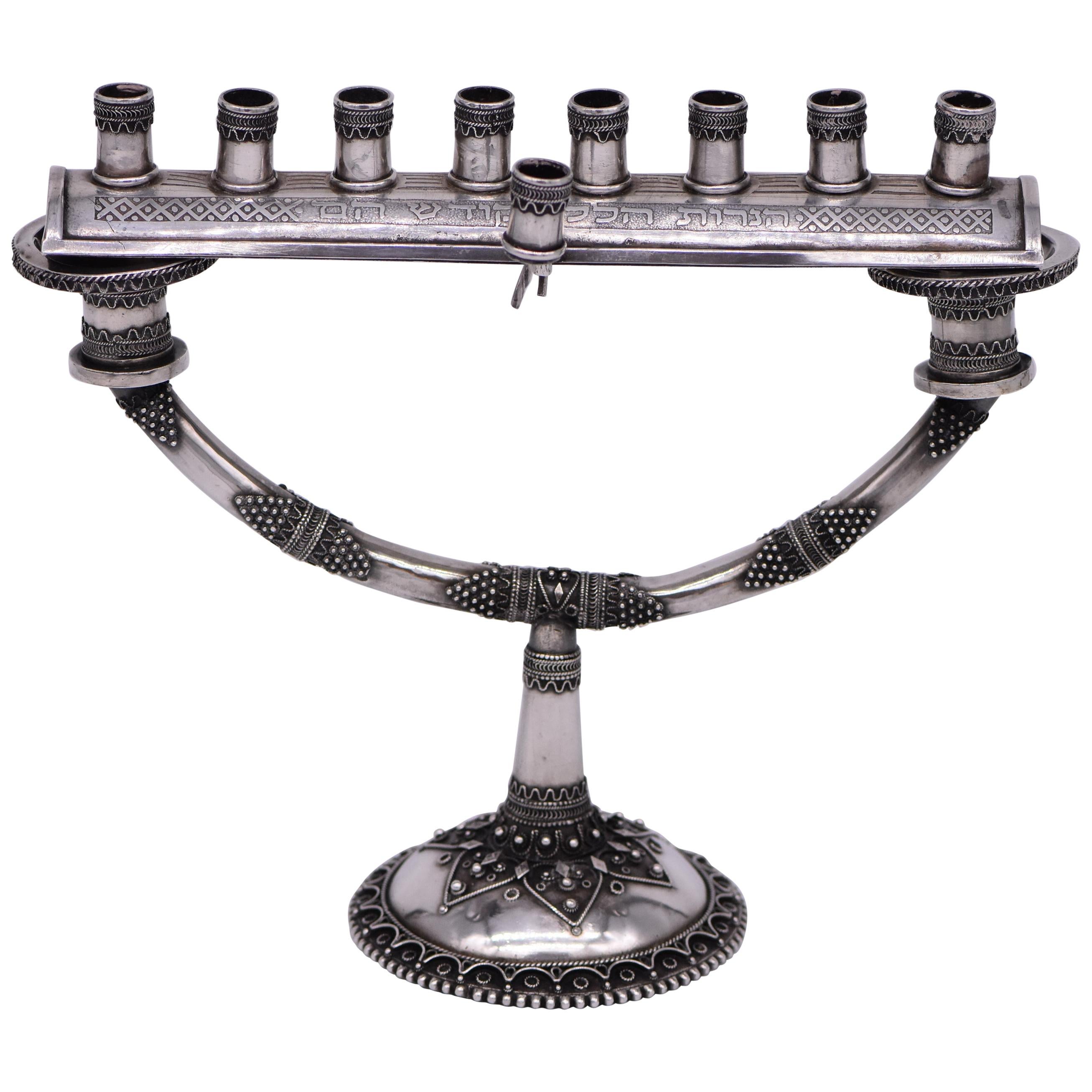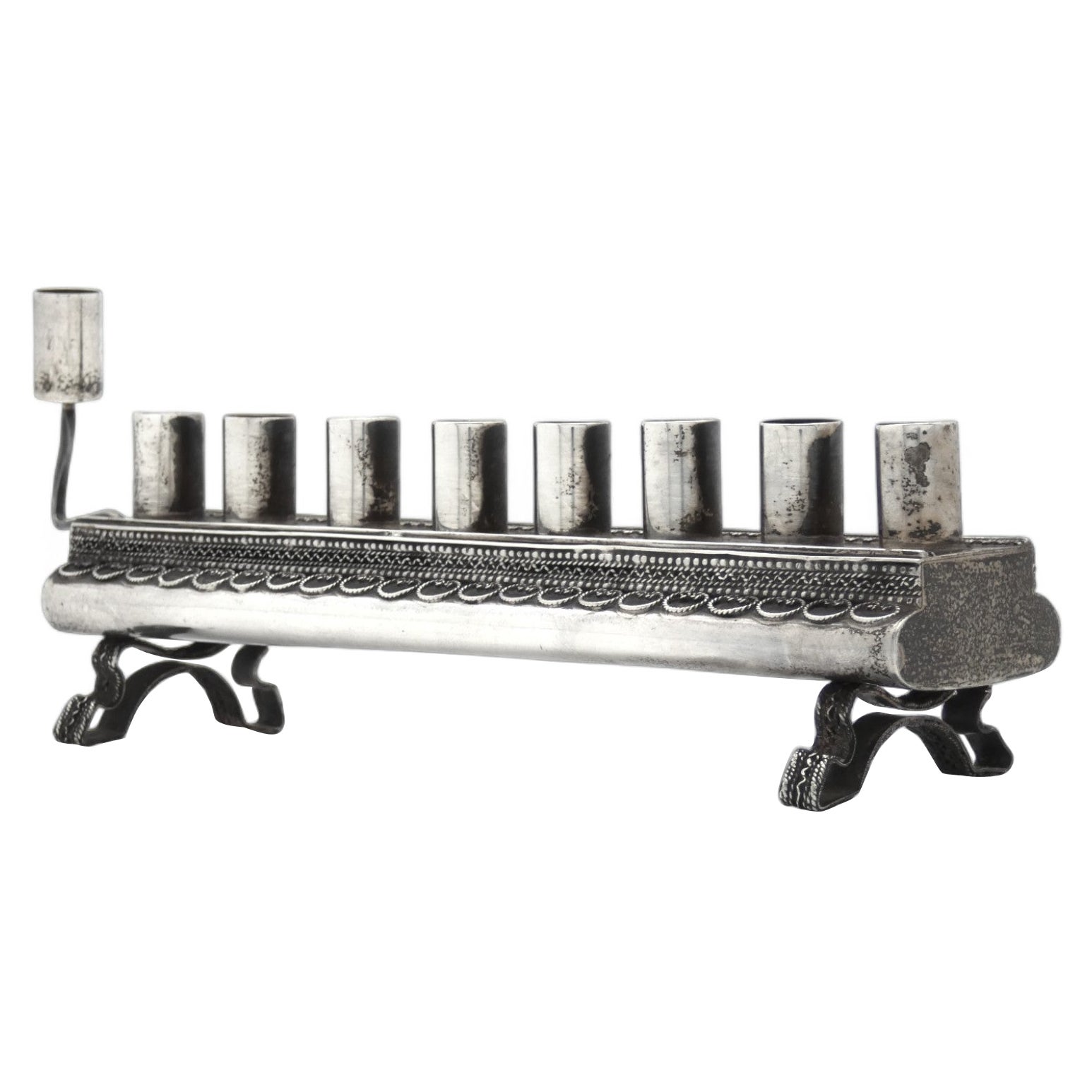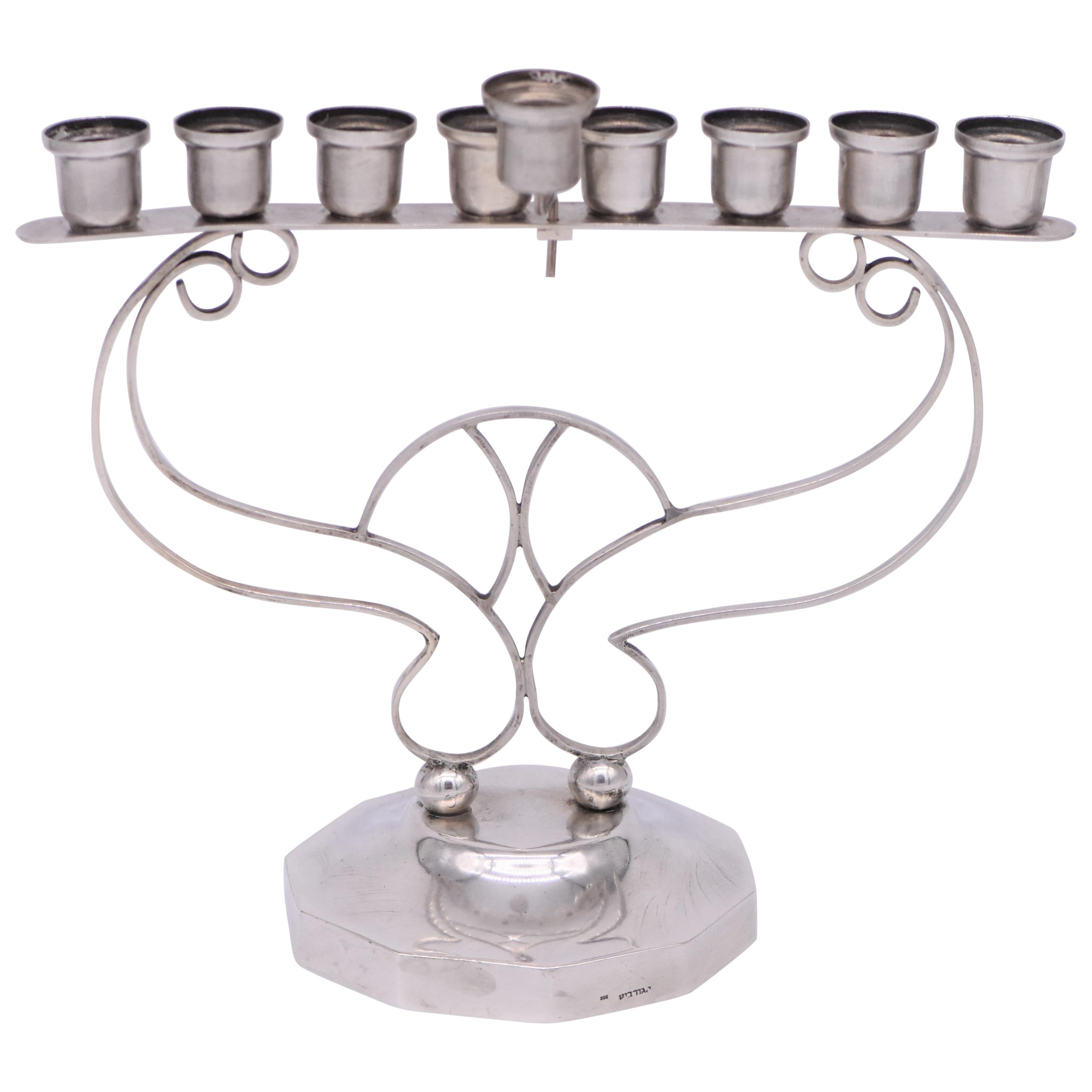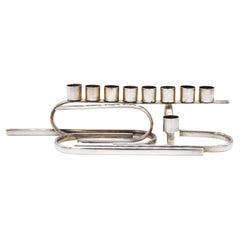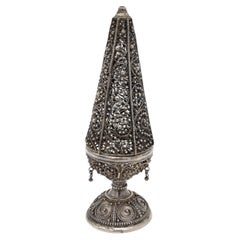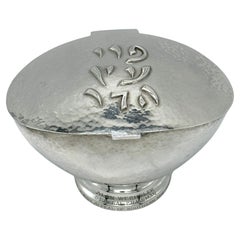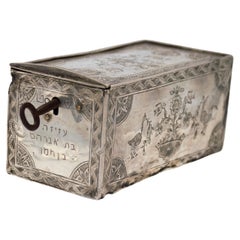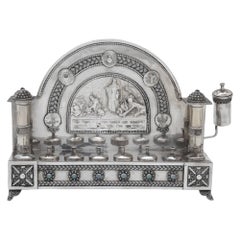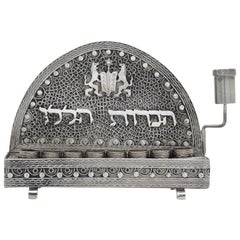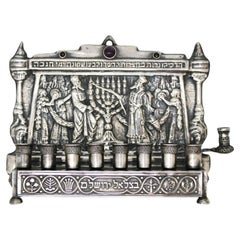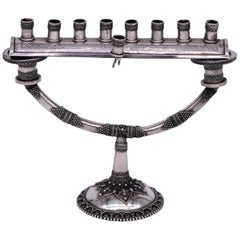Items Similar to Bezalel Jerusalem silver Hanukah lamp set with stones, Yehia Yemini circa 1920s
Want more images or videos?
Request additional images or videos from the seller
1 of 18
Bezalel Jerusalem silver Hanukah lamp set with stones, Yehia Yemini circa 1920s
$11,000
£8,306.02
€9,636.69
CA$15,458.46
A$17,222.90
CHF 8,991.17
MX$209,108.98
NOK 113,013.14
SEK 106,824.87
DKK 71,936.73
About the Item
A Silver Hanukkah lamp crafted by Yehia Yemini in Jerusalem circa 1920 is a fascinating piece of Judaica. Yehia Yemini was known for his intricate and detailed silverwork. This lamp features elaborate designs, traditional Jewish motifs, and floral filigree patterns showcasing Yemini’s high-quality silverwork skills.
The Bezalel School of Arts founded in Jerusalem in 1906, heralded efforts to forge links with a broad range of Jewish artistic traditions from East and West. The school's daring innovation offered a leading role to the local Yemenite community, particularly in the Filigree Silver Department, which was inaugurated in 1908. By 1913, the Bezalel Silver Department numbered some eighty employees, among them Yehia Yemini (1896-1983), who had been working there from the outset. Yehia Yemini distinguished himself with the quality of his work; his designs were interspersed with classical hammerings of Biblical heroes, holy places, and tribal emblems embellished with traditional verses. With his multi-dimensional perspective and outstanding Yemenite handcrafting skills, he created a pluralistic and eclectic style that came to embody the Bezalel Silver Department. The lamps backplate features a biblical scene from The Maccabean times and displays Yehuda HaMaccabi with his brothers cleansing the holy temple and its utensils after their Greek oppressors defiled them. Underneath the scene is the biblical verse which describes to the scene above. arching over the center scene is a wonderful filigree band set with turquoise and garnet. On the flat rectangular surface of the base is a row of eight inserted circular oil canisters with domed wick spout covers. The removable servant lamp is designed in a different way and it's used just to candles and not oil because it will be unsafe. Marked at the bottom back of the backplate "BEZALEL JERUSALEM" in Hebrew and another tax mark that was used on items exported from Israel.
A similar lamp is in the Boston Museum of Fine Arts, accession no. 2013.940, Charles and Lynn Schusterman Collection. That example is signed Bezalel and Yemini.
- Dimensions:Height: 4.7 in (11.94 cm)Width: 6 in (15.24 cm)Depth: 1.5 in (3.81 cm)
- Materials and Techniques:
- Period:
- Date of Manufacture:1928
- Condition:minor scratches and signs of use.
- Seller Location:Tel Aviv - Jaffa, IL
- Reference Number:1stDibs: LU8130242811632
About the Seller
No Reviews Yet
Vetted Professional Seller
Every seller passes strict standards for authenticity and reliability
1stDibs seller since 2023
- ShippingRetrieving quote...Shipping from: Tel Aviv - Jaffa, Israel
- Return Policy
Authenticity Guarantee
In the unlikely event there’s an issue with an item’s authenticity, contact us within 1 year for a full refund. DetailsMoney-Back Guarantee
If your item is not as described, is damaged in transit, or does not arrive, contact us within 7 days for a full refund. Details24-Hour Cancellation
You have a 24-hour grace period in which to reconsider your purchase, with no questions asked.Vetted Professional Sellers
Our world-class sellers must adhere to strict standards for service and quality, maintaining the integrity of our listings.Price-Match Guarantee
If you find that a seller listed the same item for a lower price elsewhere, we’ll match it.Trusted Global Delivery
Our best-in-class carrier network provides specialized shipping options worldwide, including custom delivery.More From This Seller
View AllSilver Hanukkah Lamp made by Eli Gera, modern Judaica, Israel, Tel Aviv 1970s.
Located in Tel Aviv - Jaffa, IL
Very rare and important piece of Israeli modern Judaica, a bauhaus style silver Hanukkah Lamp made by the famous jewish silversmith Eli Gera, made from hand bent And hand Forged silver in the 70s, while other works by Gera were multiplied by him, from What we Know this piece is a one of a kind.
Marked "SILVER 925" and ELI GERA in Hebrew and English
on a small silver plaque on the base.
Measurements:
Height: 3 inch / 7.6 cm
Width: 11.8 inch / 30 cm
Depth : 3.3 inch / 8.5 cm
Condition :
Perfect condition for its age, no brakes, no restorations, some minor scratches and age Related wear
About the artist :
Please note the Victoria & Albert Museum in London holds an Hanukkah lamp Havdalah Set...
Category
Vintage 1970s Israeli Bauhaus Sterling Silver
Materials
Silver
Early 20th Century Silver Spice Tower by Yehia Yemini, Bezalel School Jerusalem
Located in Tel Aviv - Jaffa, IL
Very rare Bezalel Jerusalem silver filigree spice tower, this amazing spice Tower was Made by Yehia Yemini, who was the best filigree artist in bezal...
Category
Vintage 1920s Israeli Sterling Silver
Materials
Silver
JUDAICA SILVER ETROG BOX DESIGNED BY LUDWIG WOLPERT. New York, 20th century
Located in Tel Aviv - Jaffa, IL
This charming piece of jewish history in front of you is a one of kind modern Judaica object,
This box used to hold the Etrog To protect the it during the holiday of Sukkot, it is traditionally Wrapped in silky flax fibers and stored in a special decorative box, mostly made from silver.
Wolpert designed this amazing hand hammered Bauhaus style box in 1963-1964 while he was Working in New York. all of the boxes we could found from this design made by Wolpert have The upper part inscribed in a simple engraving with the phrase "Pri Etz Hadar"
In Hebrew ״פרי עץ הדר״. the box in front of you is the only example in existence as far as we Know where the letters are also repoussé and also engraved, such a beautiful and hard to get Combination, the rest of the box is shaped as a modernistic Etrog, all the body of the box is Skillfully hand hammered in a way it reflects the light in a warm and calm way, a true Masterpiece of modern judaica by the great and important artist Ludwig Yehuda Wolpert.
One of the the two great masters of 20th century Judaica.
the Box is marked "WOLPERT" AND "STERLING" and the base has the engraved inscription :
"ALAN WECHSLER GENERAL CHAIRMAN, ALLIED JEWISH APPEAL OF SOUTHERN NEW JERSEY 1978"
Similar boxes can be find in museum collections around the world
In the Jewish Museum New York
In the North Carolina Museum of Art
In The Derfner Judaica Museum
Another similar box was featured in the Israel Museum exhibition
"Forging Ahead, Wolpert and Gumbel, Israeli Silversmiths for the Modern Age"
Ludwig Yehuda Wolpert was born in Hildesheim, Germany, to an Orthodox family. In 1916-1920, He began his studies in sculpture at the Frankfurt School of Art. In 1925-1928, he studied Goldsmithing at the Frankfurt School of Art.
Following the presentation of the works in the 1930 exhibition "Kult und Form" ("Ritual and Form") at the Jewish Museum in Berlin, his works became well known in the German Jewish World. His works were greatly influenced by Modernist design, especially the Bauhaus Movement. Wolpert's works avoid decoration, relying on clean, geometric shapes. In 1933, Following the Nazi rise to power in Germany, he immigrated to the Mandatory Palestine with His family. There he worked for two years in the workshop of Bernhard Friedländer, where he Designed and produced silverware and Jewish ceremonial art.Together with Victor Solomon...
Category
Vintage 1960s Decorative Boxes
Materials
Silver
extremely rare Algerian Judaica silver, jewish Dowry box early 19th century
Located in Tel Aviv - Jaffa, IL
Amazing and scarce JUDAICA object, we have here one of the most touching jewish objects we had for a long time, this small silver dowry box was made in Algeria in the early 19th century, it is all covered with symbols of jewish faith and of couples, the sliding lid has 2 flanking birds with hamsa (protective hand) on each side and a flower vase in the middle.
one side shows two flanking lions with a tree in the middle and the other side shows again two big and two small birds with a flower bowl in the middle, front side has a key hole and next to it there is the Hebrew inscription ס״ט״" which says Siman tov or in English "a good sign" it is taken from the wedding blessing, underneath the lock there is another inscription with the name ״עזיזה בת אברהם בן חמו״ which is the name of the bride, her father and her grandfathers name.
the box is full marked a lot of times with the silversmith mark, every side of the box is marked.
this box was probably ordered by the grooms family to hold the jewelry they are giving to the bride as dowry, this type of objects are rare and there are just a few of them on museum collections.
DOWRY (Heb. נְדֻנְיָה), the property a wife brings to her husband at marriage; the Yiddish equivalent, nadn, is from the same root. The custom of nedunyah became clearly defined and institutionalized only in the talmudic period. In biblical times, mohar (מֹהַר), whereby the groom bought his wife from her father (Gen. 24:53; Ex. 22:15–16; Hos. 3:2), was the accepted practice. It was then customary that the groom give the bride gifts, and that she bring certain property to her husband's home upon marriage: slaves, cattle, real estate, etc. (cf. Gen. 24:59–61; 29; Judg. 1:14ff.; I Kings 9:16). Evidence of the custom of nedunyah is to be found in Tobit (7:14; 8:21) and in the Assuan papyri (Cowley, Aramaic, nos. 15, 18). Gradually, mohar was superseded by the ketubbah custom according to which the husband merely assumed the responsibility of compensation to his wife in case he divorced her: he had to pay her 200 zuzim if she had been a virgin at the time of marriage, and 100 zuzim if a widow or divorcée (see *Ketubbah).
By talmudic times, the institution of nedunyah was prevalent; the father gave a dowry to the bride since the daughter was excluded from paternal inheritance. Fifty zuzim (equivalent to the worth of 180 grams of silver) was the minimum amount a father was obliged to give to his daughter (Ket. 6:5). Parents usually gave much more, according to their social standing. Community funds provided the dowry for an orphan or a very poor girl (ibid.; cf. Sh. Ar., YD 251:8). In case of her father's death, the brothers of a minor girl were obliged to give her the minimum dowry, and the court estimated how much her father would have given her above the minimum dowry. The sum was then taken out of the father's estate and given to the daughter upon majority (Ket. 6:6; 68a–69b). In the absence of such an estimate, each daughter was entitled to receive one-tenth of the value of her father's estate in money, or in valuables (Yad, Ishut, 20:4–7; Sh. Ar., EH 113:4). If the father was unable or unwilling to pay the promised dowry at the betrothal ceremony, the groom could refuse to marry his bride (Ket. 13:5; Ket. 108b–109a). Insistence on exact payment of the promised dowry, however, was frowned upon by later rabbinic authorities (Rema to Sh. Ar., EH 2:1). In certain communities it was customary for the groom's father to make a dowry contribution equal to that of the bride's father (Ket. 102b). The dowry, whether given in real estate, slaves, money, or chattel was recorded in the marriage contract (the ketubbah) and in some instances one-third or one-fifth of the actual value of the dowry was added to the sum mentioned in the ketubbah. Based upon a decree enacted by *Simeon b. Shetah (first century C.E.), the Talmud ruled that the husband and his entire property were liable for compensation as stipulated in the ketubbah, either in case he died (when she collected the sum specified in the ketubbah from the heirs) or in case he divorced his wife (Ket. 82b). For the status of the dowry and the husband's rights and obligations, see below. The rabbinic enactments (Takkanot Shum) by R. Jacob *Tam and by the rabbinic synod of the communities of Speyer, Worms, and Mainz (Germany) stipulated that if a woman died...
Category
Antique Mid-19th Century Algerian Tribal Art
Materials
Silver
Large Austrian Silver “Peacock” Hanukkah Lamp, Josef Kohn, Vienna, 1872-1900s'
Located in Tel Aviv - Jaffa, IL
Very rare and important Austrian silver, from its golden age of the late 19th century to the early 20th century, this Hanukah lamp is hand with chased dra...
Category
Antique 1890s Art Nouveau Sterling Silver
Materials
Silver
RARE Austrian silver (ALT WIEN) Havdalah spice container, Judaica ISRAEL MUSEUM
Located in Tel Aviv - Jaffa, IL
Up for sale is this museum quality Judaica Havdalah spice container, very rare with great provenance!!
This silver spice tower was made in Vienna Austria, on the early part of the 19...
Category
Antique Early 1800s Snuff Boxes and Tobacco Boxes
Materials
Silver
You May Also Like
A Silver Hanukkah Lamp by Yehia Yemini, Jerusalem Circa 1920
Located in New York, NY
A Silver Hanukkah lamp crafted by Yehia Yemini in Jerusalem circa 1920 is a fascinating piece of Judaica. Yehia Yemini was known for his intricate and detailed silverwork. This lamp ...
Category
Vintage 1920s Israeli Sterling Silver
Materials
Silver
$8,000 Sale Price
20% Off
Miniature Silver Hanukkah Lamp Menorah, I M Fain, Israel, Circa, 1950. Judaica
Located in New York, NY
The Miniature Silver Hanukkah Lamp, crafted by I. M. Fain in Israel circa 1950, is a delicate and beautifully detailed piece of Judaica.
The piece reflects mid-20th-century Israeli...
Category
Vintage 1950s Israeli Sterling Silver
Materials
Silver
$1,140 Sale Price
20% Off
A Bezalel Silver Hanukkah Lamp, Jerusalem, Circa 1920
Located in New York, NY
This remarkable Hanukkah lamp, crafted in Jerusalem by the Bezalel School around 1920, exemplifies the unique convergence of Zionist artistry, Jewish symbolism, and historic narrativ...
Category
Early 20th Century Israeli Sterling Silver
Materials
Sterling Silver
Mid-20th Century Israeli Silver Hanukkah Lamp by Bezalel School Jerusalem
Located in New York, NY
Handmade silver Hanukkah lamp Menorah by Bezalel. Decorated with filigree work, and with acid etched Hebrew text: "these candles are holy". The Menorah can also serve as Shabbat Cand...
Category
Mid-20th Century Israeli Religious Items
Materials
Silver
$3,776 Sale Price
20% Off
A Silver Hanukkah Lamp, Israel Circa 1950
Located in New York, NY
A Stylish Silver Hanukkah Lamp, made in Israel Circa 1950.
This menorah brings to mind the types of artistic designs made in Israel during that period. Schools like Bezalel were ver...
Category
Mid-20th Century Israeli Sterling Silver
Materials
Silver
$1,040 Sale Price
20% Off
Mid-20th Century Israeli Silver Arts & Crafts Hanukkah Lamp Menorah
Located in New York, NY
Handmade silver Hanukkah lamp, Israel, circa 1940s.
Beautiful Arts & Crafts Hanukkah lamp by I. Gurevitz. with great hand silver work with solid silver wires in the center, connecte...
Category
Mid-20th Century Israeli Arts and Crafts Religious Items
Materials
Silver
$1,436 Sale Price
20% Off
